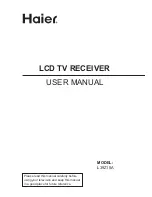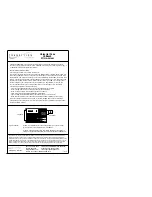
F designates the regulator option
I=Internal regulator (10-16 VDC operation with regulated RF power amplifier)
D=No regulator (7.5 VDC operation)
L=RF PA is unregulated, but the remainder of the modem is regulated (10-watt versions)
Example: A DTXM-460-OBN6I would be a UHF module for operation between 450 and 470 MHz
with a BNC RF connector, narrow (12.5 kHz channel spacing) IF bandwidth, 6 watts maximum
output power, and an internal regulator to allow operation from 10 to 15 volts.
1.3
FCC/IC REGULATIONS
1.3.1
LICENSING
For those frequency bands governed by FCC rules, the FCC requires that the radio owner obtain
a station license for his radio before using the equipment to transmit, but does not require an
operating license or permit. The station licensee is responsible for proper operation and
maintenance of his radio equipment, and for ensuring that transmitter power, frequency and
deviation are within the limits specified by the station license. This includes checking the
transmitter frequency and deviation periodically using appropriate methods. Note also, that
wideband operation (25/30 kHz channel bandwidth) may not be permitted.
1.3.2
PRODUCT CERTIFICATION
The DTXM modules are certified by the FCC for operation in the United States and by Industry
Canada for operation in Canada on certain frequency bands and sub-bands for transmission of
either voice or data signals when aligned according to the alignment procedure for the proper
bandwidth and when operated as a complete unit in the metal case. Operation of the RF board
as a stand-alone unit or in combination with any other equipment, in any mode outside the
alignment procedure, or with the clipper filter electronically disabled will require the filing of a new
type acceptance application with the FCC by the user.
1.3.3
SAFETY STANDARDS-RF EXPOSURE
RF ENERGY EXPOSURE AWARENESS AND CONTROL INFORMATION, AND
OPERATIONAL INSTRUCTIONS FOR FCC OCCUPATIONAL USE REQUIREMENTS:
BEFORE USING THIS 2-WAY RADIO, READ THIS IMPORTANT RF ENERGY AWARENESS
AND CONTROL INFORMATION AND OPERATIONAL INSTRUCTIONS TO ENSURE
COMPLIANCE WITH THE FCC’S AND IC’S RF EXPOSURE GUIDELINES.
THIS DEVICE COMPLIES WITH PART 15 OF THE FCC RULES. OPERATION IS SUBJECT TO THE
FOLLOWING TWO CONDITIONS: (1) THIS DEVICE MAY NOT CAUSE HARMFUL INTERFERENCE,
AND (2) THIS DEVICE MUST ACCEPT ANY INTERFERENCE RECEIVED, INCLUDING
INTERFERENCE THAT MAY CAUSE UNDESIRED OPERATION.
NOTE: THE
GRANTEE
IS NOT RESPONSIBLE FOR ANY CHANGES OR MODIFICATIONS NOT
EXPRESSLY APPROVED BY THE PARTY RESPONSIBLE FOR COMPLIANCE. SUCH
MODIFICATIONS COULD VOID THE USER’S AUTHORITY TO OPERATE THE EQUIPMENT.
NOTICE: This radio is intended for use in general population/uncontrolled conditions, where
users do not have full knowledge of their exposure and cannot exercise control over their
exposure to meet FCC/IC limits.





































